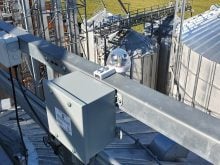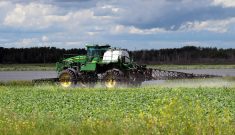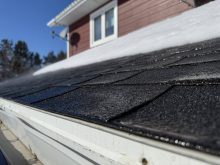On March 14, the recorded temperature of peas in this Saskatchewan hopper bottom bin was -8 C. By May 9, just 54 days later, the Bin-Sense readout had escalated to 48 C.
That’s a jump of 56 C in just 54 days. The yellow peas went into the bin at 14 percent moisture and 9 C on Dec. 1, 2018. The lowest temperature was -8 C on March 14, 2019. Then the rapid rise began.
The peas had gone through a cleaner, so there were no weeds and a minimum of fines. Those typical culprits for heating were not present. The sensor reading indicated the peas had been safely stored since early December, according to Wayne Clews of Clews Management, suppliers of Bin-Sense.
Read Also

New coal mine proposal met with old concerns
A smaller version of the previously rejected Grassy Mountain coal mine project in Crowsnest Pass is back on the table, and the Livingstone Landowners Group continues to voice concerns about the environmental risks.
“All the factors we normally blame for heating were removed from this bin. But something happened in that one bin we don’t understand. The other bins were good. The heating only happened on the top sensor, which makes me believe some moisture got in there somehow.
“Reviewing temperatures over time would lead a manager to feel pretty confident and perhaps discontinue taking reading based upon the below zero temperatures over so many months. Or cause him to ignore the alerts.”
The temperature-sensing equipment was in good working order and was turned on. The system was set up to trigger the alarm if the temperature rose more than 2 C per week. But following March 14, the temperature alerts were coming in fast and furious so the operator decided it was faulty information. He muted the alarm.
“Some guys are so busy running multimillion-dollar farms,” said Clews. “If there’s an alert, they figure it’s just an exposed sensor or something like that, so the temperature is going up and down with the ambient outside temperature. But we keep an eye on it for the customer to check for any rapid changes.
“A rise of two degrees in a week is acceptable. But if we see rises bigger than that, and we see re-occurring alerts being ignored, then it’s time for us to phone or text the operator. One thing is absolutely true. If there’s a major upward temperature trend, whatever fueled it, it never fixes itself. It’s only going to get worse.”
Clews said these situations happen when the operator hasn’t checked to see which sensors are exposed and which are covered with grain. The exposed sensors must be muted so they don’t send false signals.
He said that once you’ve done the housekeeping so you only get reports from covered sensors, the rest is easy. If you take out a load or two, you’ll expose one or two top sensors, so you have to mute them using your smart phone or laptop.
“Farmers always presume everything is OK and the grain is in good condition. If it doesn’t smell like a hog trough they presume it to be OK. The problem is they’re usually right, so they think they don’t need a system or they can ignore the alerts. But it’s that one time you’re wrong that costs you a lot of money.
“I was talking to a young guy not long ago at a trade show in Edmonton, and he told me he just couldn’t afford a system. Shortly after that he lost a quarter million dollars due to heated grain. He came back and said he’s found money for a system. The shame of it is that we might have had a system in there for him for maybe $30,000 or $25,000 to prevent the loss.
“I get emotional when I hear a guy like that tell me how much money he’s lost. It doesn’t have to happen. Stories like that and stories about the peas heating, they’re not so rare. I’ve encountered operations where they were properly set up but with no temperatures logged for 100 plus days. I’ve visited others where no one can find the monitor. Literally, it had become lost. At other operations I’ve found the memories to be full with readings from grains sold in previous years.”


















